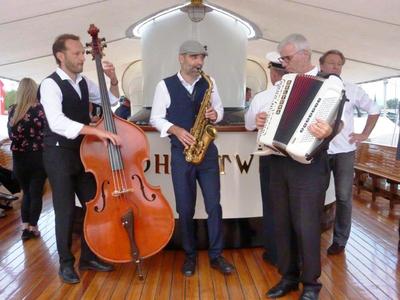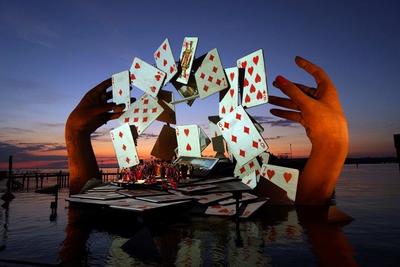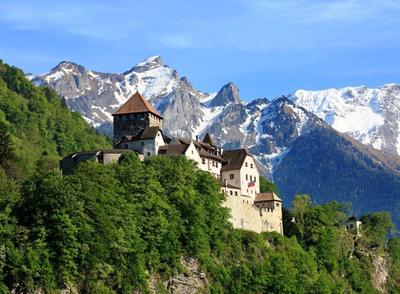BODENSEE
One lake, four countries
By Mike Pickup, Mike writes about travel for numerous newspapers and magazines, both consumer and trade, and has over a hundred features published each year. He is also the Editor of Holiday Magazine and a professionally trained photographer. For more information click here
The shores of the lake Constance fall in Germany, Austria and Switzerland and its waters flow into the Rhine which also forms a natural border with Liechtenstein. I was keen to explore the area in more detail.
Holiday Extras’ efficient Meet & Greet parking meant that I was soon on my flight to Zurich from where a short train ride took me to the lakeside city of Konstanz in Germany. It’s a lovely mix of old and new, the peaceful old sector, full of character buildings in stark contrast to the bustling modern city.
Holiday Extras’ efficient Meet & Greet parking meant that I was soon on my flight to Zurich from where a short train ride took me to the lakeside city of Konstanz in Germany. It’s a lovely mix of old and new, the peaceful old sector, full of character buildings in stark contrast to the bustling modern city.
My overnight stay was the lakeside Steigenberger Inselhotel, originally a 13th century cloistered Dominican monastery. Situated on its own island it was home to the Church Council of 1414-18 and has also served as a hospital and university. The hotel was founded in 1875 by Count Eberhard von Zeppelin who had the original monastery frescoes restored and it was the birthplace of Graf von Zeppelin, the designer of the famous airships.

Next morning, after breakfast on the terrace overlooking the lake, I headed out by road and ferry to Tettnang. On the way I went past the small airport at Friedrichshafen, now best known as the home of the current Zeppelins. A mere quarter of the length of the pre-war models, the current airships are 75m long and are powered by electric motors. There’s room for twelve passengers and two pilots and flights range from thirty minutes to two hours, the longest flight circumnavigating the lake. It’s certainly popular and at peak times needs to be booked well in advance.
Then it was on to Tettnang and a visit to Hopfengut No. 20, primarily producers of fine hops for the brewing trade it also has a small museum and a brewery to service the needs of its visitors. I was given a talk about hop growing and learned that hops are the fastest-growing plants in Europe, coming second only to Japanese bamboo. The plants grow vertically around wires suspended from a frame and the first shoots are wound clockwise around the wires to start them off. They won’t grow anti-clockwise and if they are wound the wrong way they will unravel and die. When the hops are harvested, only the growth is cut and the roots left in the ground to sprout again the following year. Needless to say I enjoyed sampling the brewery’s output as well as a traditional lunch in the restaurant before setting off again to Hard in Austria.
This small lakeside town is home to Hohentwiel, a beautifully restored royal paddle steamer. I enjoyed a gourmet five-course dinner with wines as we sailed the lake and were entertained by talented musicians. Indeed, so enjoyable was the evening that no-one noticed we had arrived back at our starting point and stayed on to enjoy the delightful hospitality.
Then it was on to Tettnang and a visit to Hopfengut No. 20, primarily producers of fine hops for the brewing trade it also has a small museum and a brewery to service the needs of its visitors. I was given a talk about hop growing and learned that hops are the fastest-growing plants in Europe, coming second only to Japanese bamboo. The plants grow vertically around wires suspended from a frame and the first shoots are wound clockwise around the wires to start them off. They won’t grow anti-clockwise and if they are wound the wrong way they will unravel and die. When the hops are harvested, only the growth is cut and the roots left in the ground to sprout again the following year. Needless to say I enjoyed sampling the brewery’s output as well as a traditional lunch in the restaurant before setting off again to Hard in Austria.
This small lakeside town is home to Hohentwiel, a beautifully restored royal paddle steamer. I enjoyed a gourmet five-course dinner with wines as we sailed the lake and were entertained by talented musicians. Indeed, so enjoyable was the evening that no-one noticed we had arrived back at our starting point and stayed on to enjoy the delightful hospitality.
Next morning a short drive took me to Bregenz. It’s famous for having the world’s largest floating stage which each year puts on a major operatic production watched by up to seven thousand people each evening seated on the lake shore. The sets are huge and impressive and the waterside setting adds a special atmosphere to the evening.
From there I walked into the town and took the Cable Car Pfander to the top of the nearby mountain. The vistas were stunning but there is so much more to do than admire the view. Local wildlife includes deer, wild boar and ibex. There’s entertainment for children, a restaurant and a number of hiking trails including a mountain trail taking in three peaks and a cheese trail.
From there I walked into the town and took the Cable Car Pfander to the top of the nearby mountain. The vistas were stunning but there is so much more to do than admire the view. Local wildlife includes deer, wild boar and ibex. There’s entertainment for children, a restaurant and a number of hiking trails including a mountain trail taking in three peaks and a cheese trail.
Back in town I enjoyed a great lake-side lunch at Pier 69. Then it was time to visit country number three, Liechtenstein.
This tiny state with a population of just 38,500 people spread over eleven municipalities is the richest in the world . However it wasn’t always this way. In 1938 Prince Franz Joseph moved from Vienna to Liechtenstein following the annexation of Austria by Germany and by the end of WWII the country was in dire financial straits. The prince sold a number of works of art to raise finance for the country. One, a painting by Leonardo da Vinci, was sold for today’s equivalent of fifty million dollars. The current prosperous nature of the country and its inhabitants is very much down to the Royal Family’s efforts and the current prince is rightly a popular ruler. Although a constitutional monarchy where the prince has the right to veto any legislation, each municipality can, if its people want, secede from the country, but then, who would want to!
The royal family live in a castle perched high on a rocky outcrop in Vaduz, the capital. The castle is not open to the public as it is very much a family home. However, guests can dine at Torkel, a restaurant owned by the Prince and situated in the palace vineyards. It’s officially the second-best restaurant in the country. On the pedestrianised main street, lined with statues, the small treasure chamber houses not only the crown jewels and an amazing collection of old armoury but one of Faberge’s famous Easter Eggs. The country was the only one with a vacuum facility capable of testing the moon landing vehicle and in response NASA presented it with a moon rock which can also be viewed there.
This tiny state with a population of just 38,500 people spread over eleven municipalities is the richest in the world . However it wasn’t always this way. In 1938 Prince Franz Joseph moved from Vienna to Liechtenstein following the annexation of Austria by Germany and by the end of WWII the country was in dire financial straits. The prince sold a number of works of art to raise finance for the country. One, a painting by Leonardo da Vinci, was sold for today’s equivalent of fifty million dollars. The current prosperous nature of the country and its inhabitants is very much down to the Royal Family’s efforts and the current prince is rightly a popular ruler. Although a constitutional monarchy where the prince has the right to veto any legislation, each municipality can, if its people want, secede from the country, but then, who would want to!
The royal family live in a castle perched high on a rocky outcrop in Vaduz, the capital. The castle is not open to the public as it is very much a family home. However, guests can dine at Torkel, a restaurant owned by the Prince and situated in the palace vineyards. It’s officially the second-best restaurant in the country. On the pedestrianised main street, lined with statues, the small treasure chamber houses not only the crown jewels and an amazing collection of old armoury but one of Faberge’s famous Easter Eggs. The country was the only one with a vacuum facility capable of testing the moon landing vehicle and in response NASA presented it with a moon rock which can also be viewed there.

If you want a Liechtenstein stamp in your passport the nearby tourist office will happily oblige.
The Liechtenstein Trail is being launched in May 2019 to celebrate the three hundredth anniversary of the country and an app has been created to describe the points of interest on the seventy-five kilometre trail.
Later that day a steep drive through many hairpin bends brought me to the village of Malbun, some five thousand feet up in the Alps, and the lovely Hotel Turna were I enjoyed a short cookery demonstration before a delightful meal and a good night’s sleep.
The Liechtenstein Trail is being launched in May 2019 to celebrate the three hundredth anniversary of the country and an app has been created to describe the points of interest on the seventy-five kilometre trail.
Later that day a steep drive through many hairpin bends brought me to the village of Malbun, some five thousand feet up in the Alps, and the lovely Hotel Turna were I enjoyed a short cookery demonstration before a delightful meal and a good night’s sleep.

My final day took me to Weinfelden and the fourth country, Switzerland, where I sampled a wine trail through the vineyards. The trail starts at the railway station and visitors can buy a special rucksack which includes a map, wine glass and a code to access the wine vaults positioned along the route so you can sample the local produce. A great way to finish my journey.
The area around Lake Constance delivers good food and wine, lovely mountain and lakeside scenery and unique visitor attractions. It’s certainly a place worth visiting.
Fact Box
The Bodensee Pass, valid for three, seven or fourteen days, gives visitors free access to many attractions and an option to include the use of the lake’s ferries. For more information visit www.bodensee.eu/en
Holiday Extras offers trusted Meet and Greet and other services at all major UK airports. To book, call 0800 1313 777 or visit www.holidayextras.com
The area around Lake Constance delivers good food and wine, lovely mountain and lakeside scenery and unique visitor attractions. It’s certainly a place worth visiting.
Fact Box
The Bodensee Pass, valid for three, seven or fourteen days, gives visitors free access to many attractions and an option to include the use of the lake’s ferries. For more information visit www.bodensee.eu/en
Holiday Extras offers trusted Meet and Greet and other services at all major UK airports. To book, call 0800 1313 777 or visit www.holidayextras.com
|
Click here for Travelling Lady's view of Bodensee
|
Want more about Germany? See Lake Constance and Weimar













